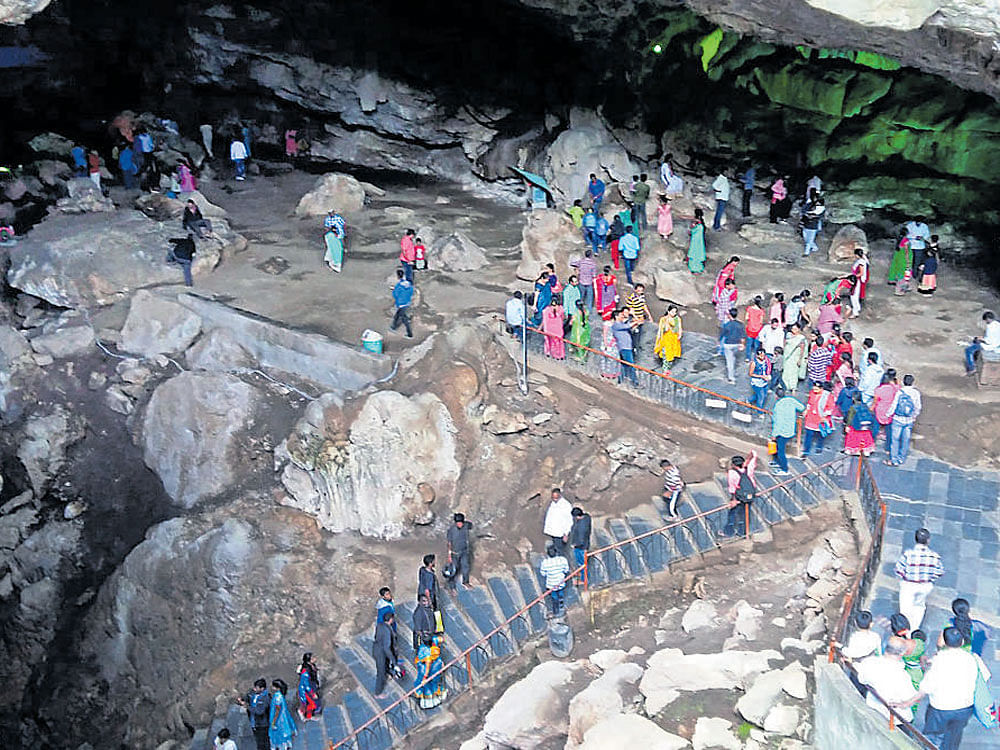
Borra (meaning hole in Odia) caves are located in the Anantagiri Hill ranges of the Eastern Ghats. The hill range is between 800 metres and 1,300 metres above mean sea level and about 90 km from Visakhapatnam.
William King, a British geologist, is said to have discovered the caves in 1807. These caves are naturally formed and believed to be 150 million years old.
Efforts are on to get World Heritage site status under the United Nations Educational, Scientific and Cultural Organisation (Unesco). The Archaeological Survey of India has asked the Andhra Pradesh tourism department to prepare documents to be presented to Unesco, urging it to consider the Archean Age ‘s cave as a natural world heritage site. The tourism department has already made the proposal and is waiting for the declaration of the tag.
According to the AP Tourism department, the recognition, if granted would give a new identity to the caves world over. The status itself confirms the outstanding and exceptional features of the listed site and it gets funds from a global body for its protection and conservation. Once listed, the status would bring international attention to the site, ensuring economic benefits. On top of it, the site becomes protected under the Geneva Convention against destruction or misuse during war.
Geologists from Andhra University in Visakhapatnam also have demanded that Borra Caves should be included in the Geo-Heritage list, stressing the need to analyse formation of the caves to study the evolution of the world.
The recent 104th Indian Science Congress at Tirupati also stressed the need for studying microbes in caves like Borra. Microorganisms that were extracted from caves are at least 50,000 years old and studying the Borra Caves system will be crucial for understanding life on earth.
A few scientists, who have been studying caves in India and had extracted DNA of microbes from minerals deep in the water of Borra Caves, say that they could be used as biomarkers to study life on the earth and beyond.
The formation of the caves is nothing but a slow and steady chemical reaction. Small streams joining the Gosthani River had a role in the cave formation. Humic acid in the water reacts with the calcium carbonate in the limestone and dissolves the minerals, breaking the rock gradually. The perennial water flow over a period of time resulted in the formation of Borra Caves. From the top entrance of the caves resembles a big hole.
The water percolating from the roof, which contains calcium bicarbonate and other minerals, could have turned into stalagmites and spear-like structures hanging from the roof called stalactites.
These two acquire different shapes inspiring the imagination of the locals and tourists and formations are described as Shiva Parvathi, mother and child, beard of sage, crocodile, tiger, cow’s udder, etc. However, the brain-shaped stalagmite in the centre of Borra Caves is certainly an eye catcher.
The main entrance of the caves is at an altitude of 705 m and one can go down up to 625 m. The total length of the caves is around 200 m but the distance the tourists trek in the cave is about 350 m through a maze of steps and ladders made by the tourism department.
Stone tools
Anthropologists at Andhra University in Visakhapatnam who conducted excavation in the caves found stone tools of middle paleolithic culture dating back 30,000 to 50,000 years indicating human habitations in the cave.
On its part, the Andhra Pradesh government, which is determined to improve tourist amenities in the Visakhapatnam-Borra-Araku circuit, has approved a new illumination plan which will be taken up at a cost of Rs 1.5 crore.
Tourists visit the caves to have a look at the limestone formations vividly displayed under bright colours. The Andhra Pradesh Tourism Development Corporation Limited is hopeful of completing the project by this summer.
The present multi-colour illumination plan was done in 1992 and needs a makeover. The illumination also helps the tourists to venture deep into the cave without fear.
Adivasi guides, who were recruited and trained by the tourism department in 1993, are threatening to agitate after Shivaratri this year, demanding better compensation and regularisation of their jobs. Tribal guides, who can speak Telugu, Odia and Hindi, are unhappy as the Integrated Tribal Development Agency and the tourism department are turning a blind eye to their pending demands.